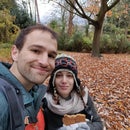Introduction: Pan Cooked Pita Bread - Pocket Flatbread
In one of my previous instructables, I made hummus, and many people asked me to share my pita bread recipe. So, long overdue, in this instructable I'll show you how to make your own pita bread :) Pita bread is a pocket-flatbread, and it is very common in many middle-eastern countries and here in Israel. We often eat pita when we BBQ (we put meat in it), with hummus, or as sandwich. And, in the spirit of the bread-and-soup contest, pitas are often eaten along a thick soup or a gravy. I like eating it with tomato soup or shakshouka.
Pita bread is delicious and, while I make it with all-purpose flour, you can use whatever flour you like! If you have any questions or comments, feel free to reach out!
Total prep time: 1hour. Net work time: 25min
Supplies
The list of ingredients is pretty short. The secrets are in the process :)
Ingredients
- Flour (1 1/2 cups)
- Sugar (1/2 tbsp)
- Fresh yeast (1/2 tbsp)
- Salt (1/2 tsp)
- Oil (3 tbsp)
- Water (1/2 to 3/4 cups)
Kitchen Supplies:
- Stove
- Large pan
Step 1: Mix Everything
Put all of the ingredients inside a large bowl and mix well. Even after it's well mixed, keep going for a couple more minutes. If the dough is too sticky, try adding a little bit of flour and oil. Too much flour will dry out the dough, and too much oil will slow down the yeast fermentation - so try not to add too much of these:)
Step 2: Divide & Shape the Dough
Once the dough is well mixed and ready to work with:
- Flour a large surface and place the dough on it.
- Divide the dough into 4 equally-sized pieces. If you want smaller pitas, you can divide the dough up to 6 pieces.
- Make sure there's enough flour, and role each portion of dough into a perfectly smooth ball.
Step 3: First Proofing
- Place the pieces of dough balls between two towels.
- Cover the dough and let it rise of about 7-10 minutes in a warm area of the house.
Step 4: Role the Dough Into Pitas
- Once the first proofing is done, use a rolling pin to turn each ball into a thin disc-like shape (about 3-5mm / 0.15" thick).
- Put the pitas back in between the two towels for the second proofing.
Step 5: Second Proofing
- Cover the pitas with a towel.
- Let the dough rise for 30-40 minutes.
- About 5 minutes before the second proofing is done, warm up a large pan on a medium-sized flame.
Step 6: Cook!
This is the trickiest part of all - this is where magic needs to happen! For the pitta bread to puff up and form a pocket, a few things need to happen. (1) There should be a crust on the outside of the dough so that the steam can't escape. (2) The pan has to be hot enough. Gradual cooking won't work. So, make sure the pan is hot before starting.
- Lay a pita dough on the hot pan. After about 10-20 seconds, flip it once.
- Let the other side cook for another 10-20 seconds, and flip it back.
- At this point your pita has a sealed crust from both sides. Now it's all about being patient. Cook the pita until it a pocket starts forming. It can take a while, and it's more than okay to scorch the pita at this point. If you have to flip it once more, go for it.
- Once a pocket starts forming, use a spatula to gently help it spread over until the entire pita is puffed (hopefully). You can look at the 2nd animation above to see what I mean.
It sounds complicated, but it's actually pretty easy :) all you have to do is - Flip-Flip-Wait!
Tip - If your pita doesn't puff - try increasing the flame. If the temperature is too low, the steam won't build up quickly enough, and the dough won't form a pocket. If none of the pitas form a pocket, all is not lost! First, it's still delicious. Second, you can manually open a pocket with a knife. It's not easy to get things right the first time, so feel free to post pictures of your pitas and I'll try to help!
Step 7: Enjoy!
Thanks for following along! I hope you enjoyed my instrucable and that you enjoy your warm pita bread!
Tip - Pita bread is best consumed while warm, but if you want to keep it for another day, you can seal it in a plastic bag while it's still fresh and put it in the freezer.
If you like my instructable, feel free to visit my instructables page and my website!
for more! See you soon!

Second Prize in the
Bread and Soup Speed Challenge













